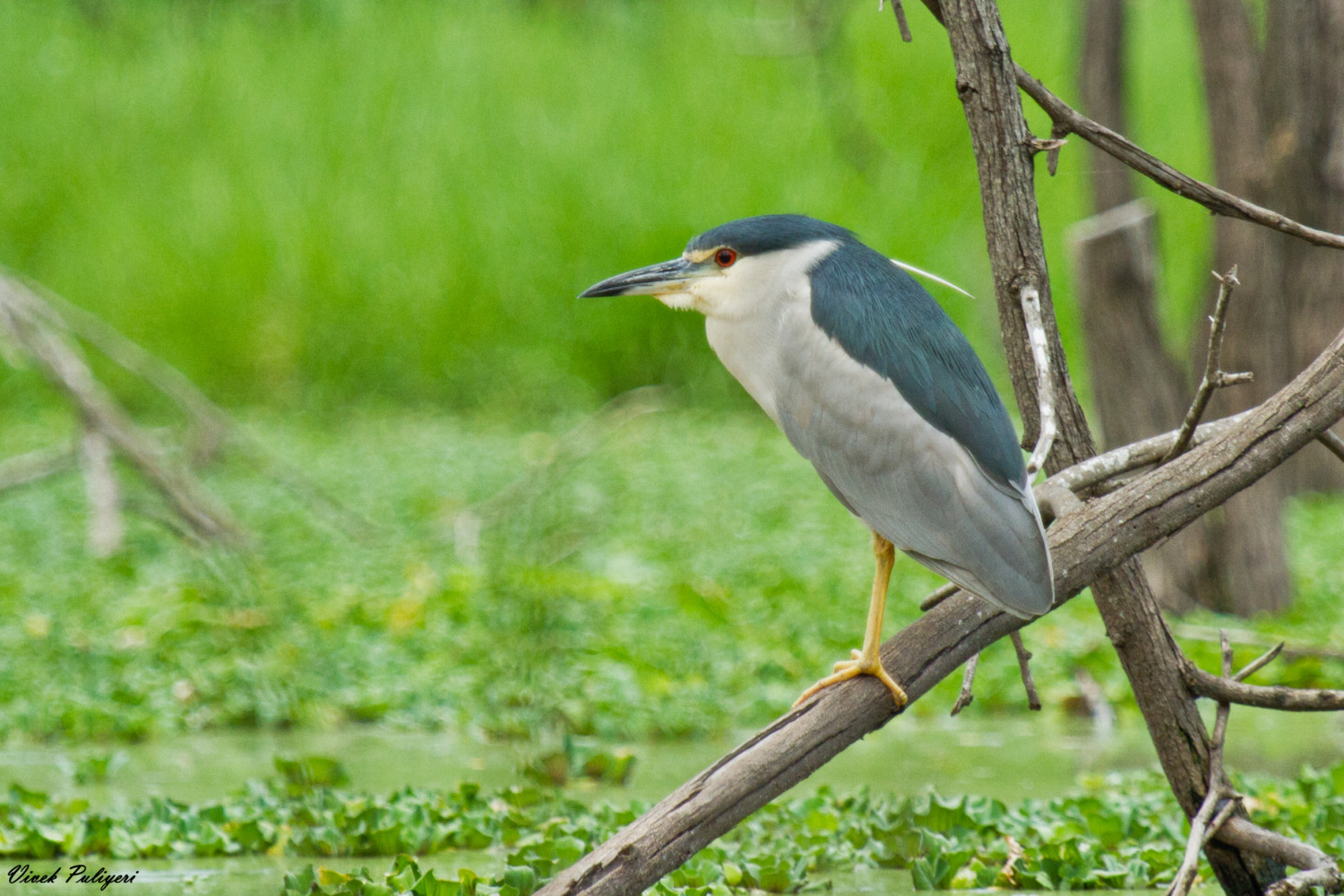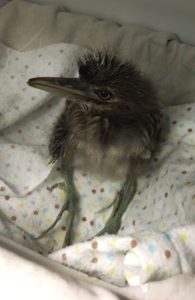
On Monday July 18th, we admitted a nestling Black-crowned Night Heron (Nycticorax nycticorax). The bird was brought in by a National Zoo employee who also volunteers at City Wildlife, after the nestling fell from its nest into one of the crane enclosures at the National Zoo. The nestling is covered in down, but it has not fledged yet, meaning it doesn’t have enough feathers or strength to fly.

Background
Black-crowned Night Herons nest very high in the upper reaches of large trees, including at the National Zoo. Usually, that means that babies that fall out of nests have severe injuries and a poor chance of recovery. But luckily for this bird, it sustained very minor injuries and is doing very well thus far! Despite the fact that it is much smaller than typical intakes of Black-crowned Night Herons, it is old enough to eat on its own and has a voracious appetite for its typical diet of small fish.
Black-crowned Night Herons, like other wading birds, eat mostly fish that they catch themselves. However, they will also eat other small animals that can be found in marshy areas and riverbanks like frogs, crayfish, snakes and rodents. As their name suggests, this species of heron does most of its feeding during the night or early morning.
The National Zoo is almost the only place to spot the migratory birds in the District of Columbia during the spring and summer. In 2015, the District of Columbia named the Black-crowned Night Heron a Species of Greatest Conservation Need within the city limits. This means that conservation and rehabilitation efforts are especially important in this area.
According to the Smithsonian Migratory Bird Center (SMBC), Black-crowned Night Herons have been breeding at the National Zoo for over 130 years, before the zoo was even established in 1889! However, that is the only known rookery in the District of Columbia, so their presence has provided a perfect opportunity for the Smithsonian researchers to study them without leaving their own backyard.

It is very common to see the adult herons fluttering around on the grounds outside (and inside) the enclosures of the other birds at the National Zoo. Caretakers receive calls each day from concerned zoo-goers that there are loose birds wandering freely around the zoo! The birds are so popular that the Zoo has begun daily feedings of the wild night herons, partly because they will otherwise eat the food intended for the other species of birds at the Bird House!
Research
In addition to local observation, the SMBC has been banding and tracking the wild birds that congregate near the Bird House in order to study their migration habits since 2013. Despite their long tenure in the DC area during the warmer months, it was unknown where the flock spent the winter months. In order to find where they winter, the researchers attached light-weight, non-harmful satellite transmitters to a few birds from the National Zoo rookery. The transmitters used technology similar to that found in cell phones to send location data to the satellite and the SMBC.
Since the beginning of the study, the center has attached transmitters to 15 birds (usually 3 per year) and has gathered an increasing amount of data. The herons usually leave the DMV around the end of August as they begin their migration south. Unfortunately, the data seems mixed thus far into the study. Some of the transmitters stopped working, but some stayed attached to the birds all the way to the next year when they returned to the zoo in March.
Some of the birds seemed to go north near Annapolis, MD for a few months before trekking along the Chesapeake Bay in Maryland and Virginia, following the coast to the Albemarle sound in North Carolina, then wintering in the warm climates of southeastern North Carolina. In previous years, the transmitter data showed some birds travelling all the way past Jacksonville, Florida towards Miami and the Everglades! The researchers hope that increases in technology will help to increase battery life of the transmitters and give them more data this year!
Make sure to check out all of the SMBC’s posts regarding their study of the Black-crowned Night Herons HERE. Pay attention year round for updates on the flock’s location. Also, check out this video the Smithsonian released for more information regarding the local population of Black-crowned Night Herons:
If you want to see the birds up close and in person before they leave, you better hurry! Sometimes the flock will stay around the National Zoo until September, but the herons begin to leave as early as the first week of August.

Rehabilitation
As for the baby heron here at City Wildlife, we will continue to care for him until he fully fledges and can fly on his own. Depending on how soon it develops feathers, it may be possible to reintroduce the heron back into its original flock (especially since the SMBC has so much data on where the birds are at any given time)! If not, we will likely transfer it to another rehabilitation center for further flight conditioning and care that we cannot manage at our own facility, before it is fully released back into the wild!
All things considered, things are looking positive for the nestling. Considering that he is relatively unharmed from his fall, eating well and in good spirits, the prognosis is good for the little heron!
If you have more questions regarding our new patient, feel free to email us at info@citywildlife.org. Otherwise, like us on Facebook and keep checking in for periodic updates on how the heron and other patients are progressing.
References:
“Herons: When Will They Return?” Expedition Blog: Black Crowned-Night Heron. Smithsonian Migratory Bird Center, 10 Feb. 2016. Web. 19 July 2016.
Youth, Howard. Field Guide to the Natural World of Washington, D.C. Baltimore: Johns Hopkins UP, 2014. Print.
Ossi, Damien, Dan Rauch, Lindsay Rorhbaugh, and Shellie Spencer. 03 2015 WildlifeActionPlan Ch2 SGCN. Washington: District of Columbia Department of Energy and Environment, n.d. PDF.
Smithsonian National Zoological Park. “Annual Houseguests at Smithsonian’s National Zoo.” YouTube. Youtube, 2012. Web. 19 July 2016.


Leave a Comment